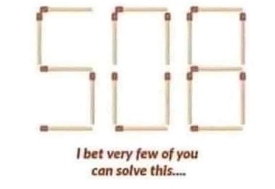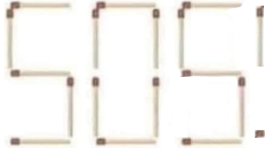Move Two Matches to Get the Largest Number

Puzzle. If you can move exactly two matches, what is the largest possible number you can get?
Many people assume that given that 508 has three digits, the answer also has three digits. They get the number 999 and stop there.
Some students realized they can make an extra 1 out of two matches and gave answers with four digits: 1503, 5051, and 5103.
Another great idea is to take out the two horizontal matches from 0, turning the 0 into 11. For example, one might use the two matches to turn 5 into 8 and get 8118. However, we can combine this idea with the previous one and use the two matches to make a new digit 1 to get 51181.
When I first saw this puzzle several years ago, 51181 was the official answer. But my students went further, much, much further.
Another elegant idea is to rotate the picture and get 81151.
Some students decided that having all the digits be the same height is not very important. One vertical match reads as 1, even if it is half the height. The largest number they got this way was 511811. Combining this idea with flipping the number allows us to get 811511.
However, small-font digits are often used in powers. This train of thought led to a brilliant answer, 511811. This number is way larger than everything we saw before: it has 41 digits. If we combine this idea with rotating the number, we can get 811511, a 43-digit number.
I recently decided to check the Internet again and discovered a chain of videos showing solutions to this puzzle by the same author. He started with a simple solution, 51181, then people left comments in the video with better solutions, so he remade the video. This happened several times. I probably should send him a link to this essay for yet another video.
Here is an interesting solution by one of my students that I haven’t seen anywhere else. The idea is to use scientific notation. The student took two matches from the right side of 0. He used one of them to convert the first digit from 5 to 9 and the second digit from 0 into the letter E. He got 9E8 = 900000000. If we combine this idea with using a small 1, we can get 5E81, an 82-digit number.
Another brilliant idea is using two matches to create a caret symbol representing an exponent. This way, we can get 5^118, which is an 83-digit number. If we combine this idea with the rotation idea, we can get 8^115, a 104-digit number.
If we ignore the relative sizes of the digits, we can have the small digits as the base of the exponent and the larger digits as the power. One of the students suggested 115118, a 5330-digit number. And if we rotate the number, the answer we can get is 118115: the number with 8451 digits. This is a humongous number compared to the mere 3-digit one we started with, to the pathetic 5-digit original solution, and to the pitiful 104-digit previous record. But my students didn’t stop there.
One student suggested snapping two matches and creating a double factorial 505!!, with 575 digits. Combining this with other ideas, we can get 8115!!, a 14102-digit number.
One of my students decided to use two matches from the last digit 8 to create a factorial sign. She glued one of the matches perpendicular to the plane to get 505! in the projection. She even made a picture that you can see below. This number has 1148 digits, and combining this with previous ideas, we can get 5118!, which has 16763 digits. Or even 8115!, which has 28202 digits.

For this puzzle, a factorial works better than a double factorial. Here is my own suggestion: use one of the matches to create a small digit one, and split the other match into a factorial. This way, we can get 81151!, a number with a whooping 363154 digits.
This is an excellent example of a thinking-outside-the-box puzzle. I love this puzzle because it has not one, but many boxes one can think outside off.
Share:
Ivan:
Let us start from here: “… One student suggested snapping two matches and creating a double factorial …” So we do a similar thing, a left factorial of 815!, i.e. !815!. This is a better solution, but unfortunately its digital length its too hard to find.
9 May 2023, 2:25 pmIvan:
I am sorry, I meant !8115!
9 May 2023, 2:27 pmtanyakh:
Cool. I never heard of left factorial before.
9 May 2023, 2:46 pmLeo B.:
To allow solutions in the form of expressions, the question must have been worded as “what is the largest possible *value* you can get?”
As posed, the final answer to the question is 811511. All subsequent tricks are not “numbers”, they are arithmetic expressions with a numerical value.
9 May 2023, 2:56 pmCalcdave:
I wonder if you could squeeze 2 of the matches into a / symbol to get something like 30/0. Perhaps infinity does not count as a “number” in this case.
9 May 2023, 3:17 pmJamas:
If you are allowed to break matches, I’m thinking up arrows, eg 5↑↑5.. and when combined with other ideas…
9 May 2023, 7:52 pmCristóbal Camarero:
With rotation, scientific notation, a little one, and factorial, we get 1E05!, of 456,573 digits.
10 May 2023, 3:47 amCristóbal Camarero:
And we can also make an E from 0 to get 5e8!, with 4e9 digits.
10 May 2023, 3:53 amIvan:
In all of the examples above the numbers are finite. If splitting is allowed, then the infinite splitting of the first match will produce 8115!!!…, which leaves a match to light the cigarette we need after the exhausting thinking.
28 May 2023, 4:39 amtarik:
To allow solutions in the form of expressions, the question must have been worded as “what is the largest possible *value* you can get?”
As posed, the final answer to the question is 811511. All subsequent tricks are not “numbers”, they are arithmetic expressions with a numerical value.
2 July 2023, 7:32 pmYami:
“One of the students suggested 11^5118, a 5330-digit number.”
8 September 2024, 5:18 pmThat’s all well and good, but if you’re going far enough to add exponents, why should they be on the right side of the number? Put them on the left side to effectively get 11↑↑5118